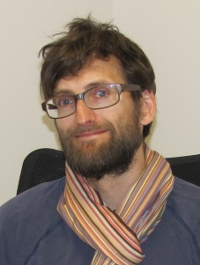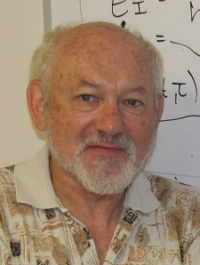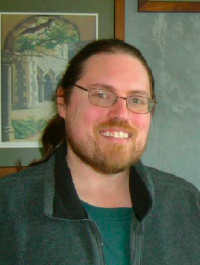Sabbatical Fellows at NIMBioS in 2012
NIMBioS supported several Sabbatical Fellows each year during the period 2010 – 2016. NIMBioS no longer provides financial support for Sabbatical Fellows, but continues to provide office space and a collaborative scientific environment for self-supported visitors. These individuals come to NIMBioS for visits of up to several months duration, with the length of stay determined by the objectives of the proposed project. For more information about self-supported visits and how to apply, click here.
Visitor/Sabbatical Archive

Matthew Spencer
(Quantitative Biology, Univ. of Liverpool)
Project Title: From short-term dynamics to long-term consequences in species-rich communities
Some ecosystems have distinct and persistent community types under the same environmental conditions, such as in the human gut, savanna and forest states in sub-Saharan Africa, forest and grassland in temperate terrestrial habitats, and coral- or algal-dominated reefs. The goal of this project is to develop statistical techniques for understanding how these patterns arise from short-term dynamics in communities with large numbers of species.
Sabbatical Dates: September 2012 to January 2013
Summary Report (pdf)
Publications
Cooper JK, Spencer M, Bruno JF. 2015. Stochastic dynamics of a warmer Great Barrier Reef. Ecology. [Online]
Presentations
Spencer M. 24 April 2013. Measuring the rate of succession. Invited Seminar, University of Sheffield, UK.

David Gurarie
(Mathematics, Center for Global Health and Diseases, Case Western Reserve Univ.)
Project Title: Mathematical models of within-host parasite-immune dynamics with applications to malaria infection: data analysis and evolution of virulence
The malaria parasite has a complex life-cycle, and many details of the immune response to the parasite are not yet fully understood. The goal of this project is to develop mathematical models and efficient computer implementation of within-host dynamics for malaria-type parasites made of multiple strains and variants interacting with the adaptive host immunity, and apply these models to agent-based approach to community transmission and selection.
Sabbatical Dates: September 2012 to April 2013
Publications
Gurarie D, King CH. 2014. Population biology of schistosoma mating, aggregation, and transmission breakpoints: More reliable model analysis for the end-game in communities at risk. PLoS ONE, 9(12). [Online]
Presentations Gurarie D. February 2013. Agent-based approach to malaria. NIMBioS Seminar Series, NIMBioS, Knoxville, TN.
Gurarie D. December 2012. Random aggregation in SIR transmission: Agent approach. Optimal Control for Agent-based Models Working Group, NIMBioS, Knoxville, TN.
Gurarie D. September 2012. Disease transmission in complex environment: How mathematics could help to predict and control infections. Colloquium, Medical School and Institute of Natural Sciences, Federal University of Minas Gerais, Belo Horizonte, MG, Brazil.
Gurarie D. September 2012. Heterogeneity in helminth infection, transmission and control. Invited address, 13º International Symposium on Schistosomiasis, Belo Horizonte, MG, Brazil.
Student Education
Gurarie D. 2013. Whole-body physiology and diabetes: Modeling approach. Special Lecture at BME 480/580 (Computational Cell Biology class), Prof. Xiaopeng Zhao, University of Tennessee, Knoxville, TN.
Software
Gurarie D. 2013. Mathematica code for "Optimal control of dynamical systems (ODE and PDE)."
Gurarie D. 2013. Reed-Frost SEIR Model (CDF tool for simulating SEIR systems with variable parameters). Wolfram Demonstrations Project. [Online]

James H. Degnan
(Mathematics and Statistics, Univ. of Canterbury)
Project Title: Extending the multispecies coalescent: Properties of unrooted gene trees and gene trees given species networks
Recent years have seen an explosion in methods for estimating evolutionary trees for species (species trees) from trees estimated at different genes in a genome (gene trees). The widely-used multispecies coalescent model, which comes from applying a population genetics model, the coalescent, to a species phylogeny, is often used to develop maximum likelihood and Bayes methods for estimating species trees from gene trees. Dr. Degnan's research extends the use of the multispecies coalescent model in phylogenetics for greater applicability to unrooted gene trees and to complex hybridization events among species.
Sabbatical Dates: January - June, 2012
Summary Report (pdf)
Publications
Zhu S, Degnan JH, Eldon B. 2015. Hybrid_sim: Simulation of multiple merger and Kingman gene genealogies in species networks and species trees. Systematic Biology, 6: 292. [Online]
DeGiorgio M, Degnan JH. 2014. Robustness to divergence time underestimation when inferring species trees from estimated gene trees. Systematic Biology, 63(1): 66-82. [Online]
Allman ES, Degnan JH, Rhodes JA. 2013. Species tree inference by the STAR method and its generalizations. Journal of Computational Biology, 20(1): 50-61. [Online]
Degnan JH. 2013. Anomalous unrooted gene trees. Systematic Biology, 62(4): 574-590. [Online]
Eldon B, Degnan JH. 2012. Multiple merger gene genealogies in two species: Monophyly, paraphyly, and polyphyly for two examples of Lambda coalescents. Theoretical Population Biology, 82(2): 117-130. [Online]
Stadler T, Degnan JH. 2012. A polynomial time algorithm for calculating the probability of a ranked gene tree given a species. Algorithms for Molecular Biology, 7: 1-9. [Online]
Yu Y, Degnan JH, Nakhleh L. 2012. The probability of a gene tree topology within a phylogenetic network with applications to hybridization detection. PLOS Genetics, 8(4): e1002660. [Online]
NIMBioS
1122 Volunteer Blvd., Suite 106
University of Tennessee
Knoxville,
TN 37996-3410
PH: (865) 974-9334
FAX: (865) 974-9461
Contact NIMBioS


